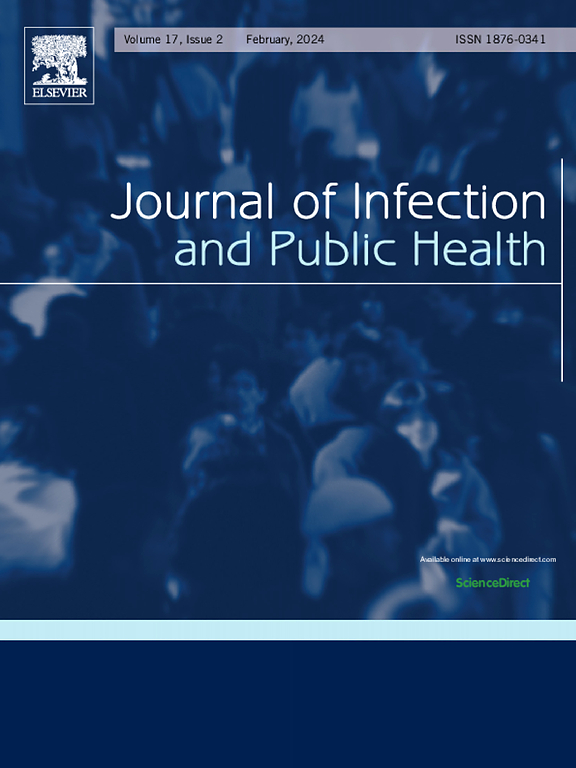2020年至2023年COVID-19病例死亡率和感染死亡率:奥地利全国分析
IF 4.7
3区 医学
Q1 INFECTIOUS DISEASES
引用次数: 0
摘要
目前还没有对整个大流行期间的COVID-19病死率(CFRs)和感染病死率(IFRs)进行全面分析,但这对于回顾性评估COVID-19疾病负担及其相关公共卫生政策至关重要。我们使用了奥地利的全国个人参与者数据,奥地利是人均SARS-CoV-2检测率最高的大陆国家,用于计算COVID-19的CFR并估计涵盖整个大流行的IFR。方法本回顾性观察性研究包括所有奥地利居民,涵盖时间为2020年2月至2023年5月,检查总体、每月和主要SARS-CoV-2变异期的CFRs。计算整个人群的CFRs,并根据免疫状况(既往接种疫苗和/或感染)、年龄、性别和养老院居住情况进行分层。我们还使用检测阳性模型根据未记录感染的估计估计ifr。结果2019冠状病毒病死率30天总CFR为0.31 %,各月差异较大,2020年4月最高为5.9 %,2022年1月最低为0.07 %。不同时期CFR均呈下降趋势,其中武汉-湖-1最高(2.05 %),ba -1最低(0.08 %)。总体cfr在没有任何免疫事件的组(0.67 %)、老年人(85 +年龄组:7.88 %)和养老院居民(7.92 %)中特别高。疗养院居民占所有COVID-19死亡人数的30.82% %,而仅占确诊感染人数的1.22% %。SARS-CoV-2感染总数估计比确诊病例高47 %,相应的总体IFR为0.16 %。结论对整个SARS-CoV-2大流行期间全国CFR和IFR的估计,对COVID-19确诊病例严重程度及其危险因素的周期依赖性变异性有重要见解。我们的研究结果进一步强调了COVID-19在老年人,特别是养老院居民中的严重程度。本文章由计算机程序翻译,如有差异,请以英文原文为准。
COVID-19 case fatality rate and infection fatality rate from 2020 to 2023: Nationwide analysis in Austria
Background
Comprehensive analyses of COVID-19 case fatality rates (CFRs) and infection fatality rates (IFRs) that span the entire pandemic are not yet available but critical to retrospectively evaluate the COVID-19 disease burden and its related public health policies. We used nationwide individual participant data from Austria, the continental country with the highest SARS-CoV-2 testing rate per capita, to calculate COVID-19 CFR and estimate IFR covering the entire pandemic.
Methods
This retrospective observational study included all Austrian residents and covered the time from February 2020 to May 2023, examining CFRs overall, monthly, and during dominant SARS-CoV-2 variant periods. CFRs were calculated for the whole population and stratified according to immunization status (presence of previous vaccination and/or infection), age, gender and nursing home residency. We additionally estimated the IFRs based on estimations of undocumented infections using a test positivity model.
Results
The overall CFR of 30-day COVID-19 mortality was 0.31 % but varied depending on month, with the highest being 5.9 % in April 2020 and the lowest 0.07 % in January 2022. The variant periods reflected this trend of decreasing CFR, with the highest for Wuhan-Hu-1 (2.05 %) and the lowest for BA.1 (0.08 %). Overall CFRs were particularly high in the group without any previous immunizing event (0.67 %), the elderly (85 + year group: 7.88 %) and in nursing home residents (7.92 %). Nursing home residents accounted for 30.82 % of all COVID-19 deaths while representing only 1.22 % of diagnosed infections. Total SARS-CoV-2 infections were estimated to be 47 % higher than confirmed cases with a corresponding overall IFR of 0.16 %.
Conclusion
This estimation of nationwide CFR and IFR across the entirety of the SARS-CoV-2 pandemic gives crucial insights into the period-dependent variability of the severity of diagnosed COVID-19 cases and its risk factors. Our findings further underline the disproportionate severity of COVID-19 among the elderly and especially nursing home residents.
求助全文
通过发布文献求助,成功后即可免费获取论文全文。
去求助
来源期刊

Journal of Infection and Public Health
PUBLIC, ENVIRONMENTAL & OCCUPATIONAL HEALTH -INFECTIOUS DISEASES
CiteScore
13.10
自引率
1.50%
发文量
203
审稿时长
96 days
期刊介绍:
The Journal of Infection and Public Health, first official journal of the Saudi Arabian Ministry of National Guard Health Affairs, King Saud Bin Abdulaziz University for Health Sciences and the Saudi Association for Public Health, aims to be the foremost scientific, peer-reviewed journal encompassing infection prevention and control, microbiology, infectious diseases, public health and the application of healthcare epidemiology to the evaluation of health outcomes. The point of view of the journal is that infection and public health are closely intertwined and that advances in one area will have positive consequences on the other.
The journal will be useful to all health professionals who are partners in the management of patients with communicable diseases, keeping them up to date. The journal is proud to have an international and diverse editorial board that will assist and facilitate the publication of articles that reflect a global view on infection control and public health, as well as emphasizing our focus on supporting the needs of public health practitioners.
It is our aim to improve healthcare by reducing risk of infection and related adverse outcomes by critical review, selection, and dissemination of new and relevant information in the field of infection control, public health and infectious diseases in all healthcare settings and the community.
 求助内容:
求助内容: 应助结果提醒方式:
应助结果提醒方式:


